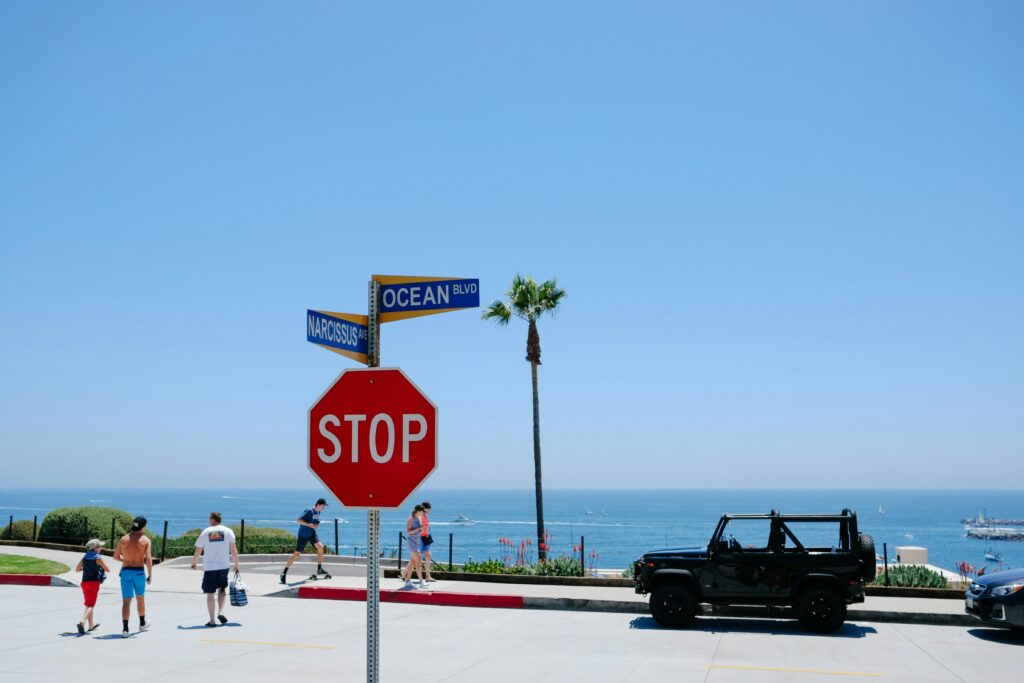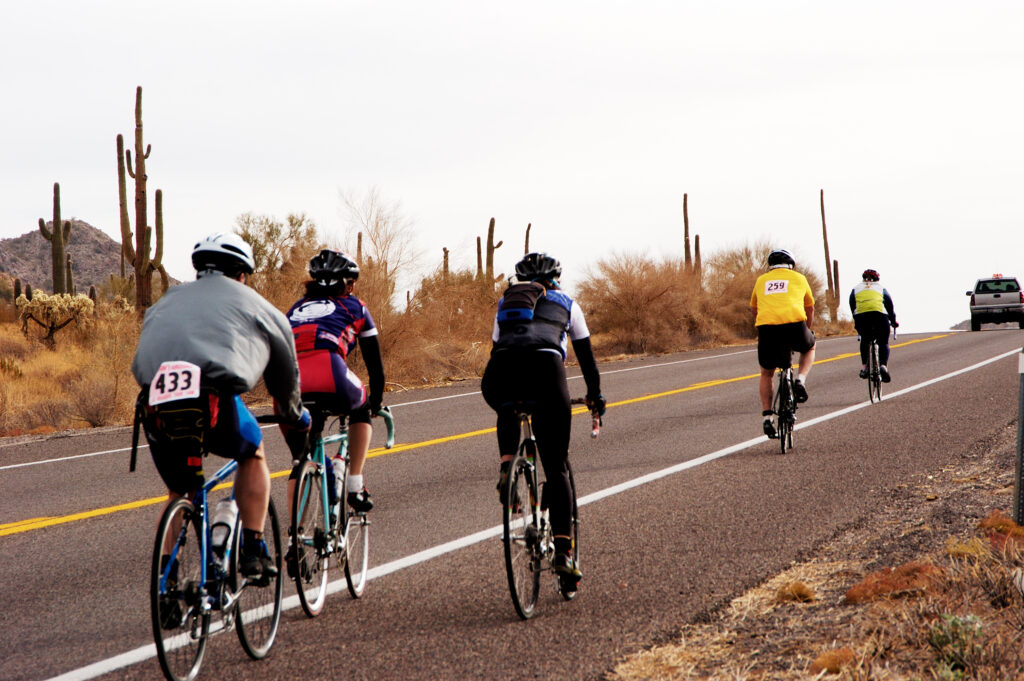Do Cyclists Have to Stop at Stop Signs? Everything You Need to Know

Do cyclists have to stop at stop signs? In most places, yes. Cyclists often must follow the same rules as cars, which includes stopping at stop signs. However, some states have different laws allowing cyclists to yield instead. This article will explain the rules for cyclists at stop signs, including differences between states, safety implications, and practical tips. Key Takeaways Cyclists in California must stop at stop signs, similar to motor vehicles, to enhance safety and manage traffic flow. The Idaho Stop Law allows cyclists to yield instead of stopping at stop signs, having shown a significant reduction in bicycle-related injuries in states that implement similar laws. The Bicycle Safety Stop Bill in California aims to allow cyclists aged 18 and over to yield at stop signs, recognizing the unique dynamics of cycling and potentially improving road safety. Understanding Stop Signs for Cyclists Photo by Joshua Hoehne on Unsplash Cyclists in California are legally required to stop at stop signs, just like motor vehicles. This means that, under California law, cyclists must come to a complete stop at all stop signs and obey all traffic devices indicating a red light, including traffic lights and traffic signals. The rationale behind this is straightforward: stop signs manage traffic flow and ensure safety at intersections. Stop signs help prevent accidents and enhance safety for all road users, including cyclists, motorists, and pedestrians, by managing the order of traffic. When approaching a four-way stop, cyclists should follow the same right-of-way rules as motor vehicles. This involves taking turns with other vehicles based on the order of arrival. Cyclists must stop behind the stop line at stop signs, ensuring they do not enter the intersection before it is their turn. After coming to a full stop, cyclists may proceed if they have regained their right-of-way. The expectation that cyclists stop at stop signs reinforces a culture of safety among all road users. When cyclists follow these rules, they contribute to a safer, more predictable traffic environment, reducing the risk of accidents and ensuring smoother interactions with other road users. The Idaho Stop Law The Idaho Stop Law, a groundbreaking piece of legislation, permits cyclists to yield at stop signs instead of coming to a complete stop. This law, named after the state that first implemented it, allows cyclists to maintain momentum by treating stop signs as yield signs when the coast is clear. The impact of this law has been significant, with a 14.5% decrease in bicycle-related injuries recorded in Idaho within a year of its implementation. States like Delaware have also adopted similar laws, with impressive results. After implementing stop-as-yield laws, Delaware saw a 23% reduction in bike collisions at stop sign intersections. Research indicates that rolling stops can lead to fewer conflicts between cyclists and motorists, as cyclists can clear intersections more swiftly and predictably, reducing the time spent in potentially dangerous zones. The Idaho Stop Law highlights a shift in how traffic laws can be adapted to better suit the unique dynamics of bicycle movement compared to motor vehicles. These laws enhance safety and traffic flow by allowing cyclists to yield instead of stopping completely, without compromising road order. Bicycle Safety Stop Bill Photo by Sean Lee on Unsplash In California, the Bicycle Safety Stop Bill, formally known as Assembly Bill 73, is a legislative effort aimed at enhancing traffic flow and safety for cyclists. This bill proposes that cyclists aged 18 and over be allowed to yield to vehicles and pedestrians when approaching a stop sign, rather than being required to come to a complete stop at certain intersections. The primary goal is to distinguish the operations of bicycles from those of motor vehicles, recognizing the unique needs and behaviors of bike riders. If passed, this legislative change would be effective until January 1, 2031, providing a substantial period to evaluate its impacts on traffic safety and flow. A report evaluating the effects of the proposed bill on traffic safety must be submitted by the California Highway Patrol by 2029, ensuring that data-driven decisions can be made regarding its continuation or modification. This bill recognizes the need to adapt traffic laws for cyclists, potentially reducing bicycle accidents and improving road safety for everyone, including bicycle laws. Consequences of Not Stopping Ignoring stop signs can have serious consequences for cyclists. Failing to stop at stop signs can also lead to dangerous interactions with cross traffic. Cyclists in California can face fines of several hundred dollars for failing to stop at stop signs. Additionally, they can be cited for disobeying traffic signs, which poses a significant risk of accidents. Enforcement of these traffic laws is essential for ensuring cyclist safety and preventing accidents. Many cyclists perform rolling stops to maintain momentum, often due to the infrequent enforcement of stop sign rules by police. However, the risks associated with this behavior are substantial. Failing to stop at stop signs can result in a $130 fine for cyclists, and more importantly, it increases the likelihood of collisions and personal injuries. The legal and safety implications of not stopping highlight the importance of adhering to traffic regulations. Understanding and following these rules helps cyclists create a safer environment for themselves and other road users. Comparing Different State Laws The approach to stop signs for cyclists varies significantly across different states. Delaware’s Yield law permits cyclists to yield instead of stopping at stop signs on two-lane roads. This law, part of the Bicycle Friendly Delaware Act, facilitates cyclists maintaining forward momentum, which enhances visibility and reduces the time they spend at intersections. Several states, including Delaware, Arkansas, and Minnesota, have adopted laws similar to the Idaho Stop that allow cyclists to treat stop signs as yield signs. These laws aim to improve traffic flow for cyclists without compromising safety. The ‘Red Light as Stop’ law in some states allows cyclists to treat red lights as stop signs, enabling safer passage after stopping. In contrast, California has repeatedly vetoed attempts to implement a yield-instead-of-stop approach for cyclists
Maricopa County Cycling: A Guide to Cycling in the Phoenix and Scottsdale Areas

Cycling in Maricopa County, particularly in the vibrant cities of Phoenix and Scottsdale, offers a unique blend of urban and scenic routes, making it a popular activity for both residents and visitors. This guide will provide comprehensive information on cycling laws, accident statistics, popular routes, and safety tips for cyclists in this dynamic region. Table of Contents 1. Introduction Maricopa County is not only the most populous county in Arizona but also one of the fastest-growing regions in the United States. With its extensive network of roads, pathways, and dedicated bike lanes, it provides an excellent environment for cycling enthusiasts. The mild climate, especially during the fall and spring months, makes cycling a year-round activity. However, it’s essential for cyclists to be aware of local laws and safety guidelines to ensure a safer and enjoyable experience. 2. Cycling Laws and Regulations in Maricopa County 2.1 Arizona Vehicle Code Arizona has specific laws that govern cycling to enhance the safety of both cyclists and motorists. Here are some key points from the Arizona Revised Statutes (ARS) relevant to cyclists: 2.2 Local Ordinances Local ordinances in cities like Phoenix and Scottsdale further refine cycling laws to address specific community needs: Understanding and adhering to these laws is crucial for ensuring a safer cycling experience and avoiding potential legal issues. 3. Bicycle Accident Statistics in Maricopa County Accident statistics highlight the importance of safety while cycling in Maricopa County. According to the Arizona Department of Transportation (ADOT) and the National Highway Traffic Safety Administration (NHTSA), the following key statistics have been observed in recent years: These statistics understand the importance of adhering to cycling laws, being aware of surroundings, and implementing safety practices while cycling. In the unfortunate event of an accident, understanding your rights and how to proceed is crucial. 4. Common Cycling Routes in Phoenix and Scottsdale 4.1 Phoenix Cycling Routes Phoenix boasts a variety of cycling routes that cater to different skill levels and preferences. Here are some popular options: 4.2 Scottsdale Cycling Routes Scottsdale is known for its picturesque landscapes and well-maintained bike paths. Here are some of the top cycling routes in the area: 5. Tips for Safer Cycling in Maricopa County To ensure a safer and enjoyable cycling experience in Maricopa County, consider the following tips: 6. How Lawyers 4 Cyclists Can Help In the unfortunate event of a bicycle accident, having the right support is crucial. Lawyers 4 Cyclists specializes in helping cyclists navigate the legal challenges following an accident. Here’s how they can assist you: If you’ve been involved in a bicycle accident in Maricopa County, don’t hesitate to reach out to Lawyers 4 Cyclists for the support you need. 7. Conclusion Cycling in Maricopa County offers a wonderful opportunity to explore the vibrant cities of Phoenix and Scottsdale while enjoying the beautiful Arizona landscape. By understanding local laws, being aware of accident statistics, and choosing safer cycling routes, riders can make the most of their cycling experience. Remember to prioritize safety and stay informed about regulations. In case of an accident, Lawyers 4 Cyclists is here to help you navigate the complexities of your situation, ensuring your rights are protected and you receive the compensation you deserve. Whether you’re commuting, exercising, or enjoying a leisurely ride, having knowledgeable legal support can make a significant difference in the aftermath of a cycling accident. With their expertise, Lawyers 4 Cyclists can help you focus on recovery while they handle the legal intricacies, providing peace of mind during a challenging time. By equipping yourself with knowledge about cycling laws, staying informed on safety practices, and knowing where to turn for help in case of an accident, you can make the most of your cycling experience in Maricopa County. Embrace the joy of cycling while remaining vigilant, and remember that Lawyers 4 Cyclists is dedicated to advocating for the rights of cyclists throughout Arizona. This comprehensive guide aims to empower cyclists in Maricopa County, ensuring they have the necessary tools and information for safer riding. Happy cycling!
10 Essential Laws to Know When Traveling with Bicycle in 2025

Cycling has become increasingly popular as a mode of transportation, especially when traveling. It’s an eco-friendly, fun, and healthy way to explore new places. But have you ever wondered about the different laws and regulations that apply to bicycles when you’re on the move? In this blog post, we’ll dive into the essential “laws to know when traveling with a bicycle”, covering topics like bike transportation, statewide bicycle laws, bike lanes, international cycling laws, etiquette, safety tips, and local resources. So, saddle up and let’s get started! Key Takeaways Bike Transportation Laws and Regulations Various transportation laws and regulations will come into play when you travel with your bike. These distinct rules, depending on whether you’re using a car bike rack, taking public transit, or flying with your bicycle, are crucial to know to avoid fines or complications. Now, let’s examine each mode of transportation, including motor vehicles, in detail. Car Bike Racks Car bike racks make it easy to transport your bicycle by attaching it to the back of your car securely. However, different states and regions may have specific laws and regulations for car bike racks. Here are some important considerations: It’s important to familiarize yourself with the laws and regulations in your area to ensure safer and legal transportation of your bike using a legal vehicle. Driving with a bike rack calls for extra caution, especially when approaching a left turn lane, as cyclists could be nearby. Being well-versed in local laws and regulations when using car bike racks as a cyclist can help evade fines and guarantee a hassle-free journey. Bikes on Public Transit Bikes on public transit are bicycles that you can take with you on public transportation, such as buses, trains, and subways. However, the rules for bikes on public transit vary by location. Generally, there are limits on the size and type of bike allowed, plus how many bikes per vehicle. Cyclists should also be aware of any specific travel lane restrictions or requirements. To find bike spots on public transit, look for signs or other indicators at the front or back of the vehicle. When using public transit, keep in mind any applicable rules and regulations, like time restrictions or permit requirements. Familiarizing yourself with these rules can help ensure a seamless journey for both you and your fellow commuters. Flying with Bicycles Before flying with your bicycle, confirm with the airline that you meet all their requirements. The laws and regulations for flying with bikes vary between airlines and destinations, and may involve proper packaging, additional fees, and adherence to specific regulations. Avoid travel complications by researching your airline’s policies and preparing your bike to meet the requirements. Statewide Bicycle Laws Awareness of the statewide laws, including state laws regarding bicycle laws, of your travel destination is vital. These laws cover helmet requirements, traffic laws, and equipment regulations, which can vary between states or countries. Comprehending and adhering to these laws contributes to your safety and that of others on the road. Helmet Requirements Helmet requirements may differ by age, location, or type of cycling activity. For example, in many US states, children are required to wear helmets when cycling. In some cities, such as Aberdeen, Bainbridge Island, Bellevue, Bremerton, DuPont, Eatonville, Fircrest, and Gig Harbor, all cyclists must wear helmets. Regardless of the local laws, it’s always a good idea to wear a helmet for your safety and protection while cycling. A helmet can significantly reduce the risk of head injuries in the event of an accident and can also help you comply with any local helmet requirements. Traffic Laws Traffic laws for cyclists typically include obeying traffic signals, riding in the same direction as traffic, and yielding to pedestrians. In Germany, for instance, cyclists must follow the same traffic laws as other road users, including those concerning drink driving, and they can even lose their driver’s license if they have one. No matter where you’re cycling, being aware of and adhering to traffic laws is crucial. This ensures your safety and the safety of other road users, as well as helps maintain a positive cycling environment. Equipment Regulations Equipment regulations often mandate specific safety features on bicycles, such as lights, reflectors, and bells. For example, in the UK, all bikes sold must come with wheel reflectors, a red wide-angle rear reflector, and amber reflectors front and rear on each pedal. Adhering to equipment regulations helps guarantee your safety and that of others on the road. Proper lighting and reflectors increase your visibility to other road users, while bells or horns can help alert pedestrians and other cyclists to your presence. Bike Lanes and Roadway Rules Bike lanes and roadway rules play a crucial role in ensuring safer cycling and coexistence with motor vehicles and pedestrians. Comprehending and abiding by these rules contributes to a safer and more pleasurable cycling experience for all road users. Proper Bike Lane Usage Proper bike lane usage involves riding in the designated direction, yielding to pedestrians, and avoiding obstructions like parked cars or debris. This helps ensure the safety of cyclists and other road users, as well as promotes the efficient use of bike lanes. Sharing the Road with Motor Vehicles Sharing the road with motor vehicles requires awareness, communication, and adherence to traffic laws. Motor vehicle operators and cyclists riding predictably, maintaining a safer distance from each other, and being prepared to yield when necessary is crucial. Motorists, on the other hand, should give cyclists at least three feet of space when passing and be aware of their presence on the road. By following these guidelines, cyclists and motorists can coexist safely on the road, reducing the chances of accidents or conflicts. Bear in mind, cyclists and motorists share equal rights and responsibilities on the road. Navigating Intersections Navigating intersections safely involves signaling your intentions, positioning yourself correctly within the bike lane or travel lane, and following traffic signs and signals. By doing so, you increase your visibility to other road users
Cycling in the Grand Canyon State: Guide to New Arizona Bicycle Laws for 2024 and 2025

As Arizona continues to grow in popularity as a destination for cyclists, whether for recreation or commuting, state legislators and city governments have taken steps to ensure the safety and accessibility of bicycling on public roads. For 2024 and 2025, several new laws and proposed ordinances are designed to address emerging issues in cycling safety, road-sharing, and infrastructure development. This article provides a detailed overview of the latest legislative changes affecting cyclists across the state, as well as proposed local ordinances in major cities like Phoenix, Tucson, and Flagstaff.
Understanding Ebike Laws: What Riders Need to Know

Ebike laws are key to riding safely and legally. This article explains e-bike classes, important federal and state laws, age restrictions, safety gear, and where you can ride. Stay compliant and safer by understanding these regulations. Key Takeaways E-bikes are categorized into three classes based on speed and assistance: Class 1 offers pedal assistance up to 20 mph, Class 2 includes a throttle for the same speed, and Class 3 provides pedal assistance up to 28 mph with no throttle. Federal and state regulations govern e-bike usage, with specific focus on safety standards set by the CPSC and varying age and licensing requirements across states to ensure safer operation. E-bike riders must adhere to traffic laws and local regulations, including speed limits, helmet use, and safety gear, to promote safer riding environments and reduce accident risks. Defining E-Bikes and Their Classes Electric bikes, or e-bikes, are bicycles equipped with a battery and an electric motor that assists with pedaling. These electric bicycles enhance pedaling, making it easier to climb hills and travel longer distances with less effort than traditional electric bike. E-bikes in the United States are categorized into three distinct classes based on their speed and the type of assistance they provide: Class 1 e-bikes offer pedal assistance up to a maximum speed of 20 miles per hour. They are perfect for those who want a bit of extra help while pedaling but prefer not to use a throttle. Class 2 e-bikes also reach a maximum speed of 20 miles per hour but include a throttle that can propel the bike without any pedaling effort. Class 3 e-bikes provide pedal assistance and can reach speeds up to 28 miles per hour, although they do not have a throttle. Each e-bike class has specific regulations and permitted usage areas. For instance, while Class 1 and Class 2 e-bikes can be used in most bike lanes and paths, Class 3 e-bikes, due to their higher speeds, often face more restrictions. Identifying your e-bike’s class ensures compliance with local laws and promotes safety. Federal regulations are key to maintaining e-bike rider safety. The Consumer Product Safety Commission (CPSC) mandates that e-bikes comply with safety standards to protect consumers. These standards cover construction, performance, and safety features, ensuring e-bikes are reliable and safer. Federal Regulations for E-Bikes The rise in e bike sales has been accompanied by an increase in e-bike accidents and injuries, highlighting the importance of adhering to these safety standards. The CPSC advises e-bike users to only utilize models that meet the established consensus safety standards for micro-mobility injuries devices. This includes features like effective brakes, functioning lights, and reflectors, which are essential for saferoperation, especially in low-light conditions. Following these standards helps e-bike riders minimize accident and injury risks. Interestingly, e-bikes are regulated similarly to traditional, human-powered bicycles under federal law. Thus, many rules for conventional bicycles also apply to e-bikes. This alignment simplifies regulations, making it easier for riders to understand and comply with legal requirements. State-Specific E-Bike Laws State-specific laws can vary widely, affecting e-bike usage despite a broad federal framework. In some states, outdated laws fail to classify e-bikes, causing confusion and legal issues. For example, in New York, e-bikes are permitted on streets and bike lanes, but local governments have the authority to impose additional restrictions. In Texas, e-bikes are treated similarly to conventional bicycles under traffic laws and do not require a special license for operation. This makes it easier for riders to use e-bikes without needing to navigate complex licensing processes. However, in other states, the regulations might be more stringent, highlighting the importance of understanding the specific laws in your state. Riders should always learn local regulations to ensure compliance and safety. Understanding the rules helps avoid fines and legal issues, ensuring a safer experience for all road users. Age Restrictions and Licensing Requirements Age restrictions and licensing requirements for e-bike riders differ significantly across the United States. In some states, such as Alabama and Alaska, riders must be at least 14 years old to operate an e-bike. Florida, on the other hand, permits individuals 16 years and older to ride e-bikes. These restrictions ensure younger riders possess the necessary skills to operate e-bikes safely. Interestingly, most states do not require e-bike riders to obtain a special license or register their bikes. For example, Wyoming has no age restrictions or licensing requirements for e-bike riders. This leniency promotes e-bikes as a convenient and accessible transportation mode for various age groups. E-Bike Road Rules and Traffic Regulations E-bike riders must follow standard traffic laws to ensure everyone’s safety. This involves obeying traffic signals, using bike lanes, and following rules for conventional bicycles. Using bike lanes and paths promotes safety and integrates e-bikes into the traffic ecosystem. Adhering to these rules is crucial, as the rise in fatal bicycle accidents involving e-bikes underscores the need for strict compliance with traffic laws. Many states, like California, have specific classifications for e-bikes that allow their use on bike paths and lanes. This ensures e-bikes are used in appropriate areas, reducing accident risks with pedestrians and vehicles. Riders should be aware of local regulations, as some areas might impose additional restrictions. Keeping e-bikes in good working condition is crucial for safety. Regular inspections, especially of brakes and handlebars, and ensuring lights and reflectors meet standards can greatly enhance safety. Helmet Use and Safety Helmet use is vital for e-bike safety, especially in preventing severe injuries during accidents. The Consumer Product Safety Commission (CPSC) warns that collisions with motor vehicles pose a significant hazard for e-bike riders. Wearing a helmet can significantly reduce the risk of head injuries, which are among the most serious in e-bike accidents. In addition to head injuries, e-bike accidents can result in severe internal injuries, making the use of comprehensive safety gear essential. Despite their importance, specific helmet laws for e-bike riders are often lacking, and regulations vary by state. However, wearing a helmet and other safety gear is imperative to minimize


